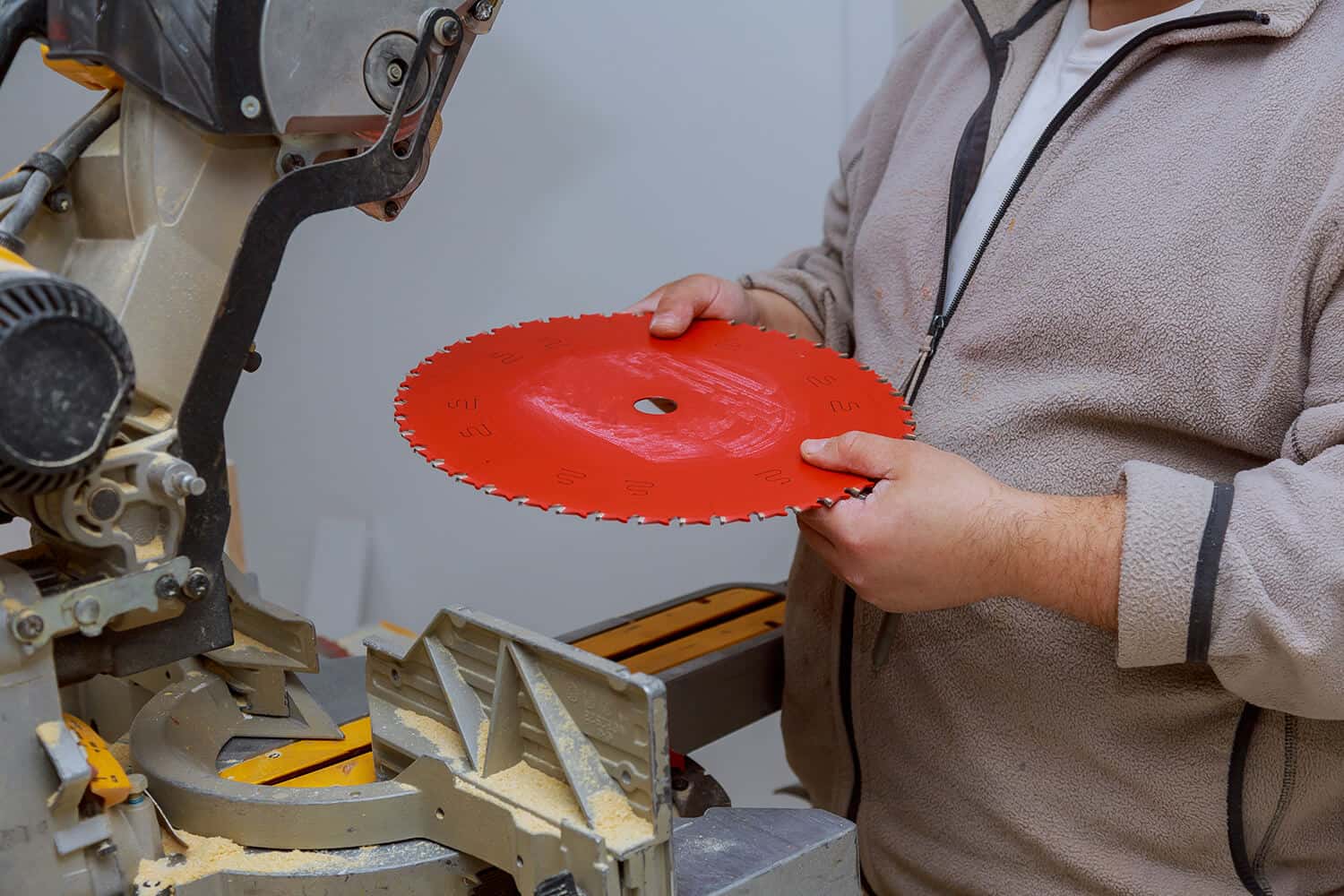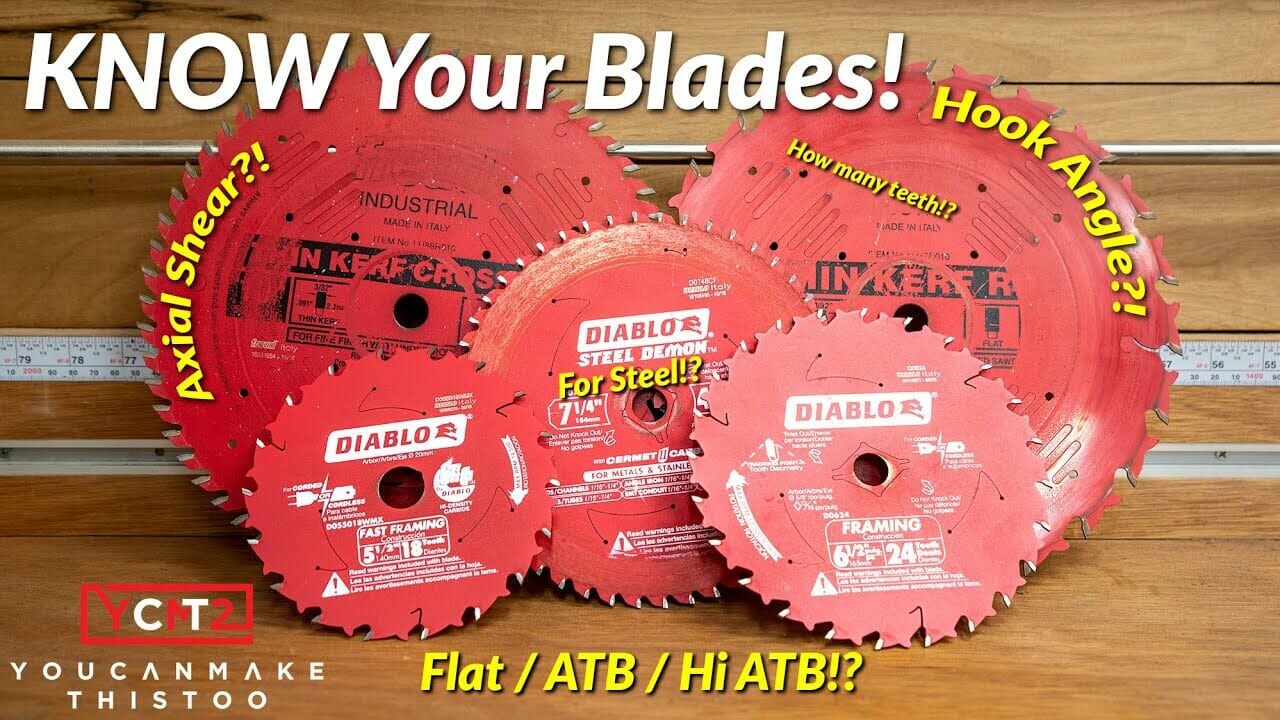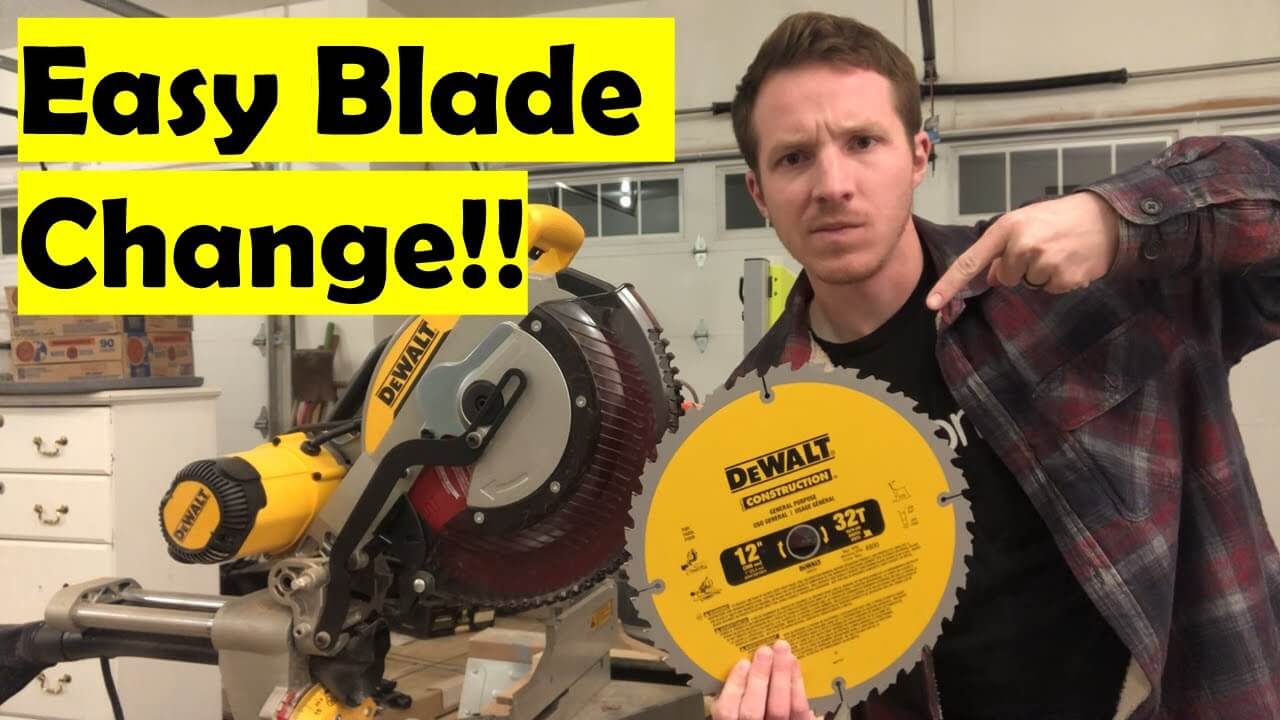How to Change a Miter Saw Blade Safely & Effectively
If you own a miter saw you notice some burn marks or intense chipping on the material you’re cutting, you’re miter blade is the likely culprit.
But, before you start tinkering with your miter saw to conduct a blade change, you’ll need to check your saw’s manual to see which type of blade it uses.
For more useful info on the matter, stick around to learn the exact steps required to change a miter saw blade. Thus simple task should take you all of 10 minutes to complete.
Why Should You Change the Miter Saw Blade?
Well for starters, if the blade on your saw is dull, it could damage the material you plan to work with. Also, sometimes the blade simply doesn’t fit the miter saws application. If you want to cut metal, you need a special kind of blade designed for this specific purpose.
There are also different kinds of blades for the same type of material, for instance, the 100-tooth blade for cutting wood pieces, and the 24-tooth blade for cutting studs.
The best part about changing your miter saw blades is that you can DIY this task with a few hand tools like a wrench and screwdriver. There’s no need to pay a professional, when you can do something yourself, free of cost, by just spending 10-15 minutes of your time.
Before you begin, make sure to buy the right replacement change blade. If you don’t know what blade you have, look, as mentioned above, at the manufacturer’s manual for your saw. In case you don’t have a manual, look up your saw model online and find out the kind of blade that fits it.
Also, make sure to get the blade that will fit your needs. This mainly depends on the type of project you’re undertaking, and the type of material.
How to Check if Your Miter Saw Blade is Dull
Sometimes a blade just looks dull, but it’s actually just dirty. When you’re cutting wood like baseboard with your miter saw, little pieces of wood accumulate on the blade. This can actually affect your work, and make you think that the blade has gone dull.
If you don’t clean your blade properly after use, this wood buildup can also corrode it. There are special solutions, called saw blade cleaners.
Before you attempt to inspect or clean your blade, make sure you isolate the power supply to your saw. Remove the blade guard, but do not try and clean the blade in position, be sure to safely remove the blade from the saw before cleaning it.
After you’ve cleaned it up and reattached it to your saw, a once dirty blade will be good as new as long as it’s not completely worn out.
In case your blade is, in fact, dull and worn out, then cleaning won’t help at all. This is when you should definitely replace it, and maybe even consider upgrading to a Diablo blade. They are seriously legit, and manufacture awesome blades.
How to Change a Miter Saw Blade
Let’s take a look at how to change the miter saw blade properly. Since there are many different brands of miter saws, check the manual (or look it up online) to see how to change the blade for your specific saw.
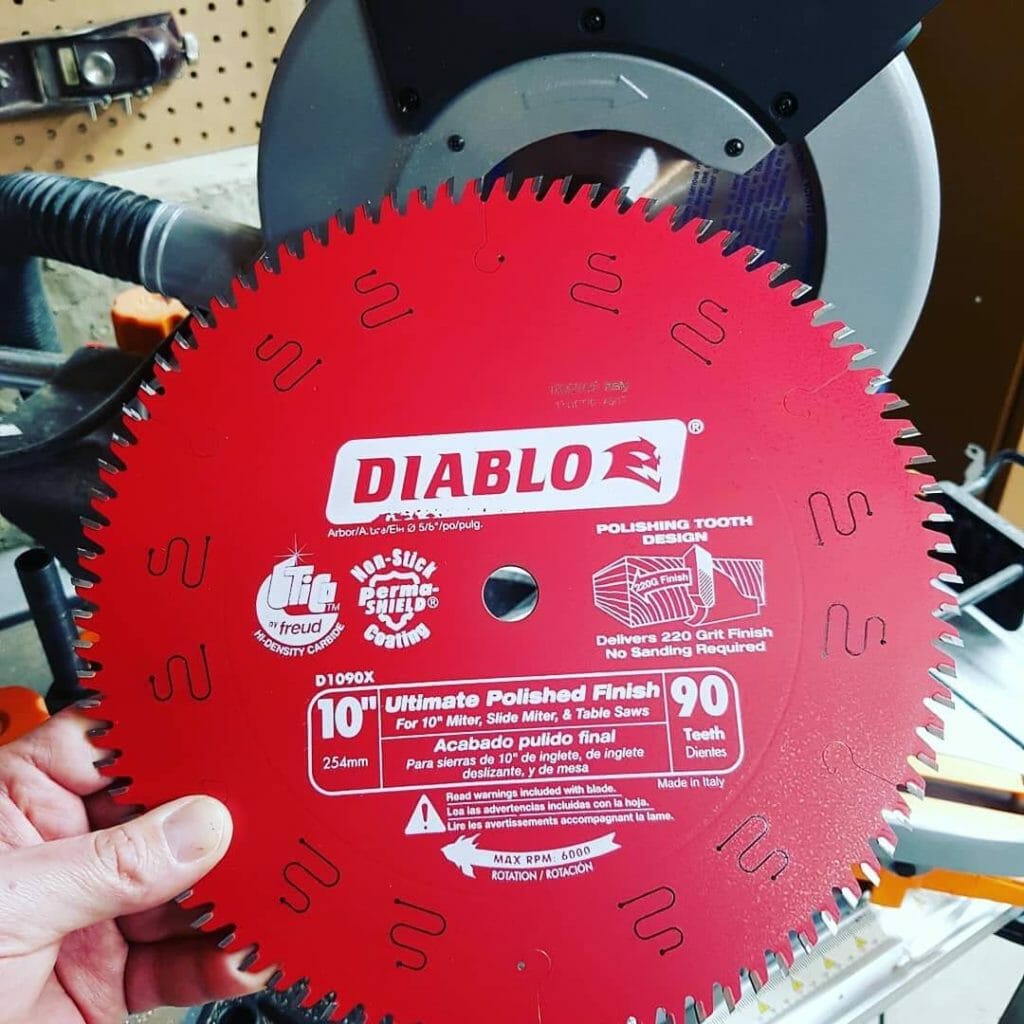
But here’s a general guide for changing miter saw blades with these simple DIY steps:
What you’ll need:
Step 1
Make sure that your miter saw is disconnected from any power source. First, you need to remove the spindle cover. Start by moving the blade guard to the top. Next, take out the front screw of the spindle cover and let it drop back to the back screw.
Step 2
With the blade guard out of the way, hold the spindle pin lock and make sure the spindle pin is tightly locked. Use a wrench to tighten it if you can’t completely lock it otherwise.
Step 3
Then use the wrench to remove the bolt holding the blade in a clockwise position. Next, remove the outer washer of the blade. You can do this with your hands. Let the inner washer remain, there’s no reason to remove the inner washer.
Step 4
After that, you can safely replace the blade. Wipe down the oil from the outer and inner washers. Be sure to add the new blade with its teeth facing downward. When you attach it properly, place the outer washer back on. Use your fingers to make sure it’s steadily attached. Refasten the bolt using a wrench in a counterclockwise motion to tighten.
Step 5
Be sure the blade is firmly attached. To avoid any risks, display caution throughout this process. Finally, use a screwdriver to reattach and tighten the blade guard to your miter saw and lower it.
Note, prior to turning on the miter saw again, check if the spindle pin lock is disengaged with your wrench and again tighten the blade bolt cover to ensure it’s fixed correctly.
How to Choose a Miter Saw Blade?
Now you know how to replace a miter saw blade, but what blade should you get? If you haven’t already decided, or are having second thoughts, here’s some additional help.
First of all, you have to look into the material you’ll be working on.
Every blade has its specific purpose. You can’t use a blade meant to be used on metal to cut wood, and vice-versa. Unfortunately, there are no universal blades, and you have to get the right one for the right job. This part is easy and straightforward, and now for the more complicated part.
There are many miter saw blades, and depending on the type of cut, you wouldn’t use the same blade to cut a 4×4 post with a miter saw as you would to cut a section of angle iron.
Miter Saw Blade Teeth Guide
You don’t need to be an expert to determine the right type of blade according to its cuts either. Just look at the number of teeth on your blade.
The blades that have fewer teeth make choppy, rough, and not very detailed cuts. On the contrary, blades with more teeth make precise, cleaner cuts. If you’re making some homemade furniture, make sure to use blades with more teeth.
If you want to cut studs, and you need to chop a lot of wood, without caring for details, use blades with fewer teeth. This is just an example. There are many variations of blades according to the kind of material you’ll be using.
You have different blades for cutting laminates, melamine, plastic, veneered plywood and panels. Then there are blades for crosscutting or ripping lumber. The blades also differ depending on their make. You have high-speed steel blades, regular steel blades, and blades with carbide tips.
Steel blades are the cheapest, but they’re very reliable for cutting softer wood. If you use it on hardwood, they’ll soon go dull. For hardwood, better get high-speed steel blades.
Carbide-tipped blades are excellent for detailing and craftsmanship. Their price is high, but they’re long-lasting and stay sharp. If precision and smoothness are what you look for in a blade then these blades are for you.
Choosing a Blade According to Its Teeth
Knowing how to replace a miter saw blade isn’t all there is to know about saw blades. You need to know the difference between blades with different amounts of teeth. As established previously, miter have between 24 and 100 teeth.
The blades with fewer teeth, around 24, are used for ripping wood. Blades used for crosscutting have from 60 to 80 teeth. Although rip blades aren’t very smooth, they can rip through hardwood without breaking into a sweat, making the cut very clean.
Crosscut blades are much smoother and don’t cause tears. They do need slower feeding, however, because they apply more individual cuts. If details are what you’re after, get a crosscut blade.
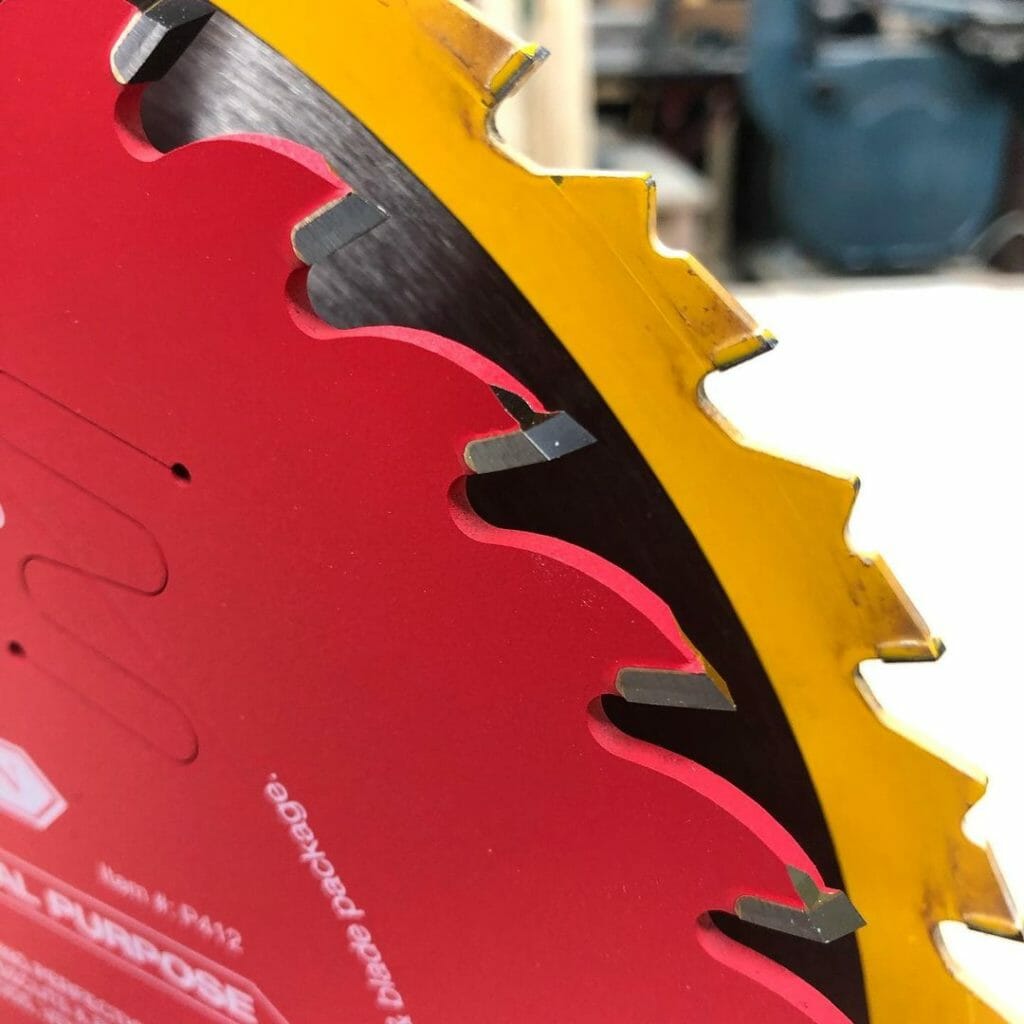
Choosing a Blade According to Its Teeth Mark
There are many different names for blades with different teeth marks. This can get a little confusing, but don’t worry, here’s what these categories or marks mean. A triple chip grind, TCG for short, is a blade for cutting hard and heavy materials.
An alternate top bevel or ATB is a blade that alternates between the left and the right bevel. Their cuts are very smooth and clean. The high alternate top bevel, Hi-ATB, is used for very smooth crosscutting. These blades can also cut materials with melamine surfaces.
Flat top, or FT, are blades that are very versatile. They can rip soft and hardwoods, and they quickly remove the material.
Finally, the combination tooth, or comb for short, is extremely versatile. You can use it both for crosscutting and also ripping wood.
Choosing a Blade According to Its Teeth Hook Angle
Finally, there’s one last thing to consider about miter saw blades. Besides the marks of teeth on the blade, teeth can also have varied hook angles. The hook angle refers to the face of the teeth facing to the front or to the back.
The teeth facing forward have a positive hook angle, in the direction of the rotation. The negative hook angle teeth face away from the rotation.
Hook angles are in fact very important, and they determine how the blade works. The negative hook angle is slower and more precise. Positive hook angle blade teeth give quicker and more aggressive cuts, i.e. these are for rip blades.
Miter Saw Blade Tips and Tricks
You need to take good care of your miter saw if you want its blade to stay sharp and if the tool lasts longer. The things that often go wrong with these saws are the bolts and screws. They can rust, and cause problems.
The best solution is to lubricate your miter saw with a greasy solution. Always check the main bolt of your saw, and make sure it’s tightly fixed using a wrench. Make sure every bolt and screw is firmly in place before you plug in the tool to any power supply.
Many people ask about wobbling. It’s a known issue, but you can get rid of wobbling by leaving some free room between the blade and the nut.
In Conclusion
You have now learned how to successfully change a blade on a compound miter saw but remember to take good care of your miter saws and their blades. If you lubricate them properly and clean up once in a while, you won’t have to change the blades so often.
In addition, you now know a lot more about the various kinds of blades, blade teeth, marks, and so on. All of which are relevant when picking the right replacement miter saw blade.
Still, make sure that you get a blade that fits your miter saw, according to its brand and size of miter saw to buy.
Following these straightforward steps to replace your miter saws blade will keep your cuts clean, which will exhibit a higher standard of craftsmanship with your finished products.

